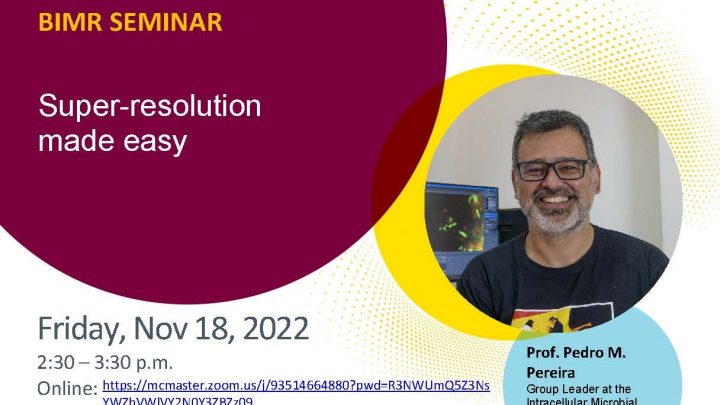Super-resolution made easy
Nov 18, 2022
2:30PM to 3:30PM

Date/Time
Date(s) - 18/11/2022
2:30 pm - 3:30 pm
Categories
Prof. Pedro M. Pereira
Group Leader at the Intracellular Microbial Infection Biology lab, Mostmicro, ITQB NOVA.
Online only: https://mcmaster.zoom.us/j/93514664880?pwd=R3NWUmQ5Z3NsYWZhVWlVY2N0Y3ZBZz09
Fluorescence microscopy has revolutionized cell biology. It’s ubiquitously used to observe cellular processes thanks to its ease of use, sensitivity, and molecular specificity. The diffraction limit is a thing of the past. Super-resolution (SR) techniques allow the visualization of subcellular organization way below the classical ~200 nm diffraction limit. The only question that may trouble a scientist is which one to use. The challenge of selecting the best-suited approach for a particular research question is compounded by the fact that these approaches can often be expensive and complex, requiring dedicated equipment, complicated sample preparation procedures and entail a compromise between temporal/spatial resolution and innocuity to living cells. This prompted the development of new software, hardware and sample preparation strategies that can effectively democratize SR and made is accessible to any research group. I will show you some of these developments. From Super-Beacons, a new class of DNA-based probes for live-cell super-resolution, to NanoJ-Fluidics, a LEGO-based open-source fluidics system for multi-modal imaging, with a quick visit into how we can expand biology above diffraction with expansion microscopy!
Bio:
I am a cell biologist with experience in microbiology, host-pathogen interaction, and advanced microscopy approaches. I graduated in applied chemistry from NOVA university in Lisbon in 2006 and completed a master’s in biotechnology the following year. I finished my PhD in cell biology 2013 where I explored questions related to antibiotic resistance and cell division in the human pathogen S. aureus, during this time I started to explore different microscopy approaches such as classical fluorescence microscopy, super-resolution microscopy and atomic force microscopy. This interest prompt my move to University College London, UK, where I did a postdoc focussing on the development of hardware, software and probe based technological innovations for (super-resolution) microscopy (e.g. NanoJ-Fluidics). In 2019 I returned to Portugal, where, since October 2021, I have my own research group at ITQB NOVA, the Intracellular Microbial Infection Biology (IMIB) laboratory. I’m currently interested in understanding how extracellular bacterial pathogens transition into an intracellular infection “lifestyle” and how antibiotic challenges modulate this behaviour.

